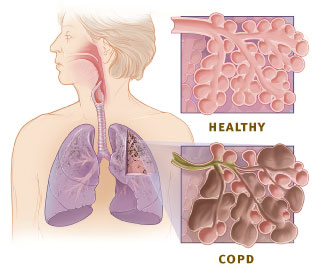Tips for Living with COPD
According to Centers for Disease Control and Prevention, chronic obstructive pulmonary disease (COPD) is the third leading cause of death in the United States, claiming more than 120,000 lives each year and affecting about 30 million people. Half of whom don’t even know they have it.

“Breath” by Mae Chevrette, via Flickr, CC BY 2.0
What is COPD?
COPD is a preventable and treatable disease and is characterized by shortness of breath and chronic coughing. An umbrella term, COPD includes a number of progressive lung diseases, including emphysema and chronic bronchitis, that make it hard to breathe.

In the United States, smoking is the leading cause of COPD, accounting for as much as 90% of diagnoses – most patients smoke or used to smoke.
Other causes include long-term exposure to irritants, such as secondhand smoke, air pollution, or chemical fumes or environmental dust that damage the lungs and the airways, untreated asthma and, rarely, a genetic condition called alpha-1 antitrypsin deficiency.
There are several treatment options available to decrease the frequency and severity of symptoms, increase exercise tolerance and generally improve quality of life. It is important for patients to discuss their individualized treatment plan with their doctor, which may involve a combination of inhaler medicines, oxygen therapy, pulmonary rehabilitation and proper immunizations.
Tips for Living with COPD
While there is no cure, there are many things you can do to manage the symptoms of COPD.
Monitor Air Quality
Believe it or not, indoor air can sometimes be more polluted than outdoor air, especially in winter, when we’re cooped up with the windows closed all the time. According to the Asthma and Allergy Foundation of America, there are three major airborne threats in a home: allergens, irritants and dangerous chemicals.
Here’s how you can purify the air in your home:
- Ventilate the home by opening windows and running exhaust fans.
- Don’t allow smoking.
- Minimize dust mites by cleaning linens and surfaces regularly, lowering the humidity level, removing clutter that can catch dust and keeping pets off your furniture.
- Inspect air conditioner regularly for mold and mildew in the duct work. Consider installing an air filtration system.
- Reduce your exposure to household chemicals such as paints, varnishes and cleaning products.
Quit Smoking
If you’re a smoker, the most important thing you can do is quit now. Encourage those around you to do the same, as breathing in secondhand smoke will only worsen your condition.
Medications, Oxygen and Vaccines
A wide range of medications and treatments are available — from pills or capsules to inhalers. Talk to a doctor about which is best for you.
- Controller medications are taken every day — even when you’re feeling good — to help keep the lungs open so you can breathe as well as possible and stay active.
- Rescue inhalers provide immediate relief. The best way to treat COPD is to take a controller medication every day, and use a rescue inhaler when you need it.
- People with COPD are at a high risk of pneumonia and can have severe complications from the flu, so getting vaccinated against these viruses can reduce the risk.
- Your doctor can prescribe oxygen therapy, which can reduce shortness of breath and will help you to stay more active.
Exercise
Exercise can change the way you feel, breathe and function. Be sure to check with a healthcare provider before starting any exercise program or new activity. Initially, the exercise routine should be slow and easy and can gradually increase over time.
Early detection is key.
The earlier the stage in which COPD is diagnosed and treated, the easier it is to manage and increase quality of life for the patient.
November is National COPD Awareness Month. The official color for COPD is orange, which is also the color that the U.S. Environmental Protection Agency’s Air Quality Index uses to represent days with unhealthy air quality for sensitive groups, including people with lung disease.
Early diagnosis begins with awareness and education. Here are 4 things YOU can do to live a longer, more active life.
- Be aware of the risk factors
- Recognize the symptoms
- Ask your doctor or health care provider about a simple breathing test
Taking Control
Using a smartphone-based app for tracking symptoms daily can help patients suffering from chronic obstructive pulmonary disease adhere to treatment in 90% of users, according to research published in Telemedicine and e-Health.
The ability to consistently and accurately track daily symptoms can lead to detection and treatment of worsening symptoms, according to the report’s authors. In addition, fast response to such symptoms can avert hospital readmittance, boost recovery and improve quality of life for patients.
The research findings align with another study, revealing that smartphone and real-time communications between home-based COPD patients and providers can boost treatment and help reduce hospital readmissions.
Activ Doctors Online’s personal health record makes it easier to organize and track your COPD symptoms online, including:
- Physical activity
- Weight
- Medications
- and more!
And, our secure e-Consultation platform allows you to connect and share valuable health information with your doctors, which can lead to improved outcomes.